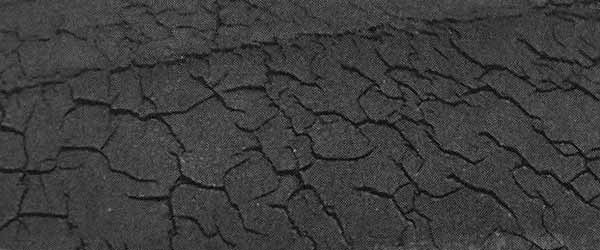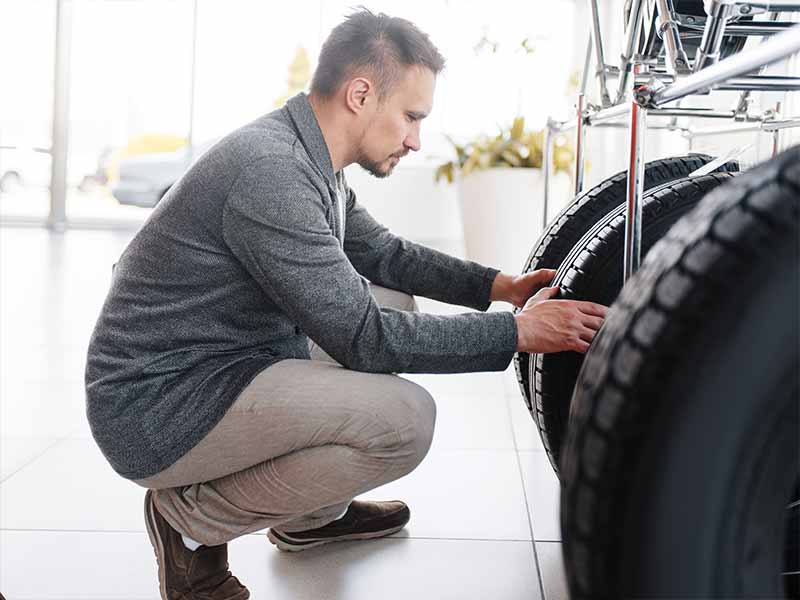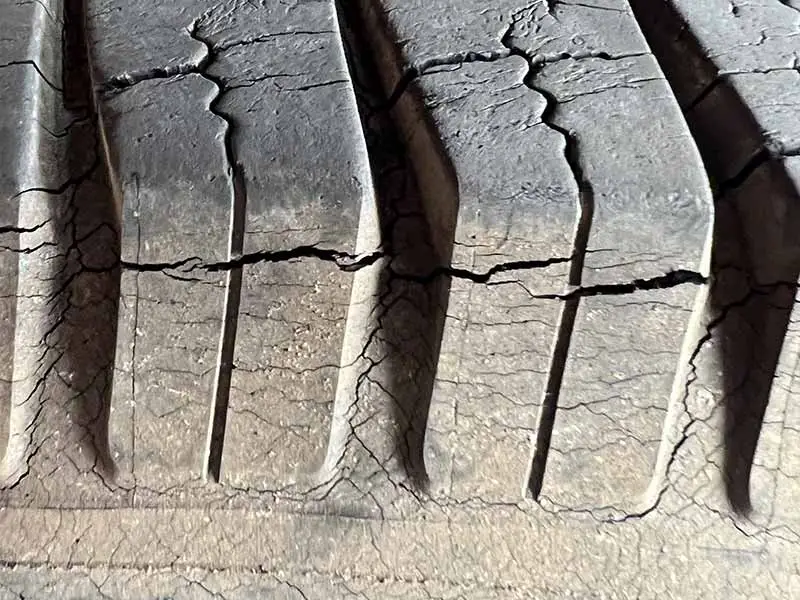There’s an average for how long a tire will last before dry rot begins, but it can happen sooner and shorten tire life if your tires are exposed to certain situations.
How Long Before Tires Dry Rot?
Tires generally start showing signs of dry rot after about 6 years from the date of manufacture found on the tire sidewall.
However, factors such as proper storage, usage, and maintenance can impact the onset of dry rot and either prolong or shorten the life of your tires.
In this article, we’ll explore the causes of dry rot and offer practical tips to help you prevent, stop, and even fix this pesky problem. More importantly, we’ll show you how to store your tires safely to avoid dry rot and maximize their lifespan.
Let’s take a closer look.
What Causes Dry Rot On Tires?
Dry rot on tires is a troublesome issue that not only shortens the life of your tires but can also pose a safety risk. To help you better understand this problem, let’s delve deeper into the primary factors that contribute to dry rot on tires.
Ozone And UV Exposure
One of the leading causes of dry rot is the exposure of tires to ozone and ultraviolet (UV) rays. Ozone is a gas present in the atmosphere, and it can be harmful to the rubber compounds in tires. Prolonged exposure to ozone causes the rubber to lose its elasticity, resulting in the formation of cracks. UV rays from the sun have a similar effect, as they break down the tire rubber and make it brittle and weak. Over time, the combined impact of ozone and UV exposure leads to dry rot.
Heat And Temperature Fluctuations
Heat and changes in temperature also play a significant role in causing dry rot. When the weather is hot, the rubber in tires expands, making it more susceptible to damage. Conversely, when it’s cold, the rubber contracts, which can weaken its structure. Repeated exposure to these temperature fluctuations accelerates the aging process of the rubber, causing it to crack and develop dry rot.
Infrequent Use And Tire Age
Interestingly, not using your car enough can contribute to dry rot. When a vehicle remains stationary for extended periods, the weight of the car presses down on the tires, creating stress points and leading to the formation of cracks. Moreover, as tires age, the rubber loses its natural oils and flexibility, becoming more prone to dry rot.
Improper Storage
How you store your tires can also affect the development of dry rot. If tires are stored in an environment that’s too hot or too cold, or exposed to direct sunlight, they can sustain damage. It’s essential to avoid storing tires near heat sources, such as furnaces or heaters, or electrical equipment, which can generate ozone. As mentioned earlier, ozone is detrimental to tire rubber and can exacerbate dry rot.
Low Tire Pressure
Maintaining proper tire pressure is essential for preventing dry rot. Underinflated tires can lead to uneven stress on the tire rubber, causing it to wear and crack more easily. Ensuring your tires are always inflated to the manufacturer’s recommended pressure can help minimize the risk of dry rot.

My Favorite UV Protectant For Protecting Tires From UV Damage
How To Prevent Dry Rot
Taking care of your tires is essential for preventing dry rot and ensuring a safe and smooth driving experience. Here are some practical tips to help you keep dry rot at bay and prolong the life of your tires.
Regularly Driving Your Car Or Truck
One of the simplest ways to prevent dry rot is to use your car regularly. Driving your vehicle helps to keep the rubber in your tires flexible and prevents it from becoming brittle. If you know you won’t be using your car for an extended period, try to move it every few weeks to redistribute the weight and minimize stress on the tires.
It also helps the ozonate, a chemical included in the rubber that is designed to help protect the tires, to migrate up to the surface from deeper within the rubber.
Proper Tire Inflation
Maintaining the correct tire pressure is crucial for preventing dry rot. Underinflated tires can lead to uneven stress on the tire rubber, causing it to wear and crack more easily. Check your tire pressure at least once a month and always inflate them to the manufacturer’s recommended level. This will help ensure even wear and reduce the risk of dry rot.
Parking In Shaded Areas
Whenever possible, park your vehicle in a shaded area or garage to minimize its exposure to direct sunlight. UV rays from the sun can cause the rubber in tires to break down and become brittle, leading to dry rot. By parking in shaded areas, you can protect your tires from harmful UV rays and prolong their lifespan.
Tire Protectant Sprays
Using a high-quality tire protectant spray can also help prevent dry rot. These sprays create a protective barrier on the surface of the tire, shielding it from ozone, UV rays, and other environmental factors that can cause dry rot. When using a tire protectant, be sure to follow the manufacturer’s instructions for the best results.
Regular Tire Inspection
Inspecting your tires regularly is crucial for identifying early signs of dry rot and addressing them before they become a significant problem. Look for cracks, cuts, or signs of wear on the tire sidewalls and tread. If you notice any issues, consult a professional to determine the best course of action.
Rotating Your Tires
Rotating your tires every 5,000 miles or so can help ensure even wear and reduce the risk of dry rot. Tire rotation involves moving the tires to different positions on your vehicle, which helps distribute the weight evenly and prevents stress points from forming on the rubber.
Level One Dry Rot

Level Two Dry Rot

Level Three Dry Rot

Level Four Dry Rot

Level Five Dry Rot

How To Stop Dry Rot Once It’s Started
If you’ve noticed signs of dry rot on your tires, don’t panic! While it’s essential to address the issue as soon as possible, there are steps you can take to halt the progression of dry rot and potentially extend the life of your tires. Here’s what you can do:
Identify Early Signs Of Dry Rot
The first step in stopping dry rot is to recognize the early warning signs. Look for small cracks, cuts, or signs of wear on the tire sidewalls and tread. If you notice any of these issues, it’s time to take action to prevent further damage.
Clean And Protect The Tires
Thoroughly cleaning your tires can help remove any dirt or debris that may be contributing to the dry rot. Use a gentle tire cleaner and a soft brush to clean the tire surface, making sure to rinse it thoroughly with water afterward. Once the tires are clean and dry, apply a high-quality tire protectant spray. This will create a protective barrier on the tire surface, shielding it from ozone, UV rays, and other environmental factors that can cause dry rot. Be sure to follow the manufacturer’s instructions for the best results.
Check And Maintain Tire Pressure
Ensure your tires are always inflated to the manufacturer’s recommended pressure. Underinflated tires can lead to uneven stress on the tire rubber, causing it to wear and crack more easily. Checking your tire pressure at least once a month and maintaining proper inflation can help minimize the progression of dry rot.
Limit Exposure To Harmful Elements
Whenever possible, park your vehicle in a shaded area or garage to minimize its exposure to direct sunlight and heat. These factors can accelerate the aging process of the rubber and worsen dry rot. Additionally, avoid storing your tires near heat sources or electrical equipment, as these can produce ozone, which can further damage the tire rubber.
Consult A Professional For Tire Inspection
If you’re unsure about the severity of the dry rot or need advice on how to address the issue, consult a tire professional. They can inspect your tires, assess the extent of the dry rot, and recommend the best course of action. In some cases, they may suggest replacing the tires to ensure your safety.

How To Fix Tire Dry Rot
It’s important to understand that once dry rot has reached an advanced stage, it’s not possible to completely “fix” or reverse the damage. However, there are some measures you can take to manage the issue and potentially extend the life of your tires. Here’s what you can do:
The Limitations Of Fixing Dry Rot
Keep in mind that “fixing” dry rot doesn’t mean the damage will disappear. Instead, the goal is to slow down the progression of dry rot and mitigate its effects. In some cases, tires with dry rot may still be safe to use for a limited time, but it’s essential to consult a professional to assess their condition and ensure your safety.
The Role Of Tire Sealants
There are some tire sealants on the market that claim to help repair minor cracks and damage caused by dry rot. While these products might provide a temporary solution, they’re not a long-term fix and should be used with caution. Always follow the manufacturer’s instructions when using tire sealants, and remember that they are not a substitute for proper tire maintenance and care.
When To Replace Tires With Dry Rot
If the dry rot has reached a severe stage, the best course of action may be to replace the affected tires. Continuing to drive on tires with advanced dry rot can pose a safety risk, as the weakened rubber is more prone to blowouts and other issues. Consult a tire professional to assess the condition of your tires and determine whether they need to be replaced.

Air Tight Storage Bags Protect Tires From Harmful Ozone
How To Store Tires Without Dry Rotting
Properly storing your tires when they’re not in use can significantly reduce the risk of dry rot and help prolong their lifespan. Follow these tips to ensure your tires are stored correctly and protected from harmful elements:
Proper Storage Conditions
- Cool, Dark, And Dry Spaces: Choose a storage location that is cool, dark, and dry to protect your tires from heat, direct sunlight, and moisture. These factors can accelerate the aging process of the rubber and contribute to dry rot. A climate-controlled storage area, such as a basement or insulated garage, is ideal.
- Away From Heat Sources: Keep your tires away from heat sources like furnaces, heaters, or electrical equipment, which can generate ozone. As we’ve mentioned earlier, ozone is harmful to tire rubber and can exacerbate dry rot.
Storing Tires Off The Ground
Place your tires on a clean, flat surface, and keep them off the ground, if possible. Using a tire rack or storage system can help prevent your tires from coming into contact with moisture, dirt, or debris on the floor, which can contribute to dry rot.
Use Of Tire Storage Bags Or Covers
Consider using tire storage bags or covers to protect your tires from dust, dirt, and other environmental factors that can cause dry rot. These covers can also help shield your tires from ozone and UV rays, further reducing the risk of dry rot.
Deflate The Tires Partially
If you’re storing tires mounted on rims, consider deflating them partially to reduce stress on the tire sidewalls. This can help prevent the development of cracks and dry rot. However, don’t deflate them completely, as this can cause damage to the tire bead.
Store Tires Vertically Or Horizontally
Depending on the available space and your preference, you can store your tires vertically (upright) or horizontally (stacked). If you choose to stack your tires, make sure not to stack them too high, as this can create excessive pressure on the bottom tire and cause damage.
Resources
Below are some links you may find helpful when learning about tires
- Protecting classic car tires from dry rot – Gold Eagle
- How to tell if your tires are dry rotted and need replacement – NAPA
Final Thoughts
Understanding the causes of dry rot and taking preventive measures can make a huge difference in the lifespan and safety of your tires. We’ve explored various ways to prevent, stop, and manage dry rot, as well as how to store tires properly to minimize the risk of this issue.
As the famous saying goes, “An ounce of prevention is worth a pound of cure.” By being proactive and applying the tips we’ve shared, you can ensure your tires stay in great shape, providing a safer and more enjoyable driving experience for years to come.
Good luck and happy motoring.





